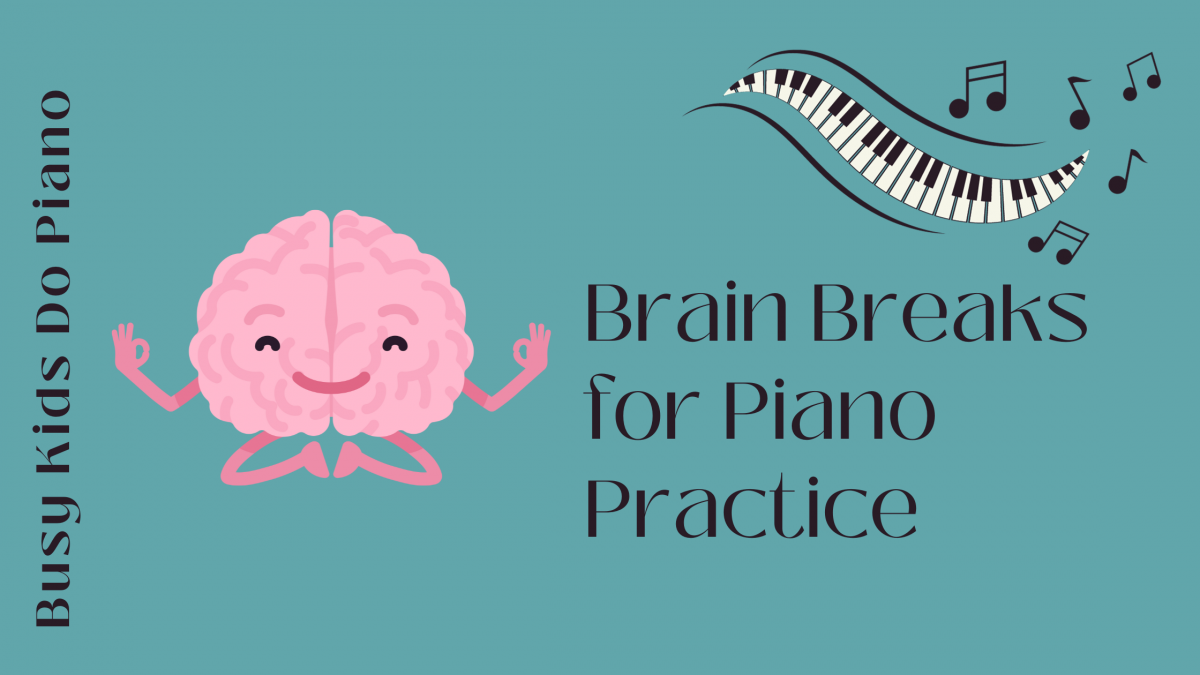When my daughter was in kindergarten, I often volunteered in her classroom. Upon my first visit, I was struck by a brilliant concept I had never heard of or experienced: brain breaks.
As the teacher transitioned the class from one subject to another, she would lead them in one of these “brain breaks”. Sometimes they would count to ten and touch their toes. Other times she’d turn on a video of a song that they’d sing along to. The kids LOVED them, and I could sense the entire group of wiggly little ones refocusing before moving onto the next subject.
My children, now in 1st and 4th grade at the time of this writing, still enjoy regular brain breaks during their school day. I love that the teachers implement them. I also recognize that both my typically developing child and special needs child benefit from them.
A few years ago, I began to incorporate this same idea of brain breaks into my piano lessons. Whether I was teaching a student in a private lesson or a group of 7 energetic boys in a group class, doing a few stretches or something playful to break up the lesson had tangible benefits.
I also recently began having my children take brain breaks during their practices. I noticed immediate benefits to this new structure!
Here are some reasons to incorporate brain breaks into your child’s piano practice.
BRAIN BREAKS INCREASE FOCUS
Sitting at the piano bench for an extended period of time can make a student antsy. (And an extended period of time for a 5-year-old is different than an extended period of time for a 10-year-old!) Getting your piano student to move around a bit carries blood and oxygen to the brain. This re-energizes the brain and allows it to focus again.
BRAIN BREAKS PREVENT OVERWHELM
In order for new info to become a memory, it has to pass through the amygdala into the prefrontal cortex. If your piano student is becoming anxious, confused or frustrated as he practices, the amygdala – an emotional filter in the brain – becomes overly active and turns into a stop sign. No information will pass through the amygdala to reach the prefrontal cortex and become a memory.
All that is a really scientific way of saying that brain breaks during piano practice can help your student return to a place of calm. When she is in that place of calm, she can successfully learn new things.
BRAIN BREAKS SUPPORT EMOTIONAL AWARENESS
During my recent interview with behavioral therapist Meg Smith, we talked about addressing behavioral issues that can come up during piano practice. One of the things that Meg really stresses is helping your child to develop self awareness as well as empowerment.
Encouraging your child to request brain breaks as well as reassuring her that you will provide them during practice is powerful. She feels empowered to ask for one if she needs it, giving her a sense of control over the practice session. She also begins to develop awareness and pay attention to her body’s cues that might indicate she needs a break. This is such a valuable skill!
So now that you understand how beneficial brain breaks can be in piano practice, how should they be administered? Here are some pointers for including brain breaks in your piano practice structure.
BRAIN BREAKS SHOULD BE QUICK
No need to draw out a brain break into something that makes piano practice feel even longer! Keeping the activity to less than 2 minutes is perfectly adequate and provides all the benefits a brain break is designed to give.
USE BRAIN BREAKS WHEN THINGS ARE GOING WELL
Don’t wait until your child is squirming uncontrollably or crying in frustration to administer a brain break. Think of them as a preventative tool. By switching the type of mental activity for your student, you’re giving his brain a chance to replenish and rejuvenate before a breakdown.
Are you wondering what a brain break during piano practice looks like?
I’ve put together a list of music-themed brain breaks designed to be fun, silly and get your child moving in between scales and arpeggios. Download my printable list of musical brain breaks by clicking the bar below:
- Brain breaks are a valuable tool to prevent overwhelm, help students focus and ensure more efficient piano practicing.
- Use brief brain breaks during piano practice before your child begins to fall apart or become fatigued.





However, researchers note that there’s currently a lack
of high quality data.